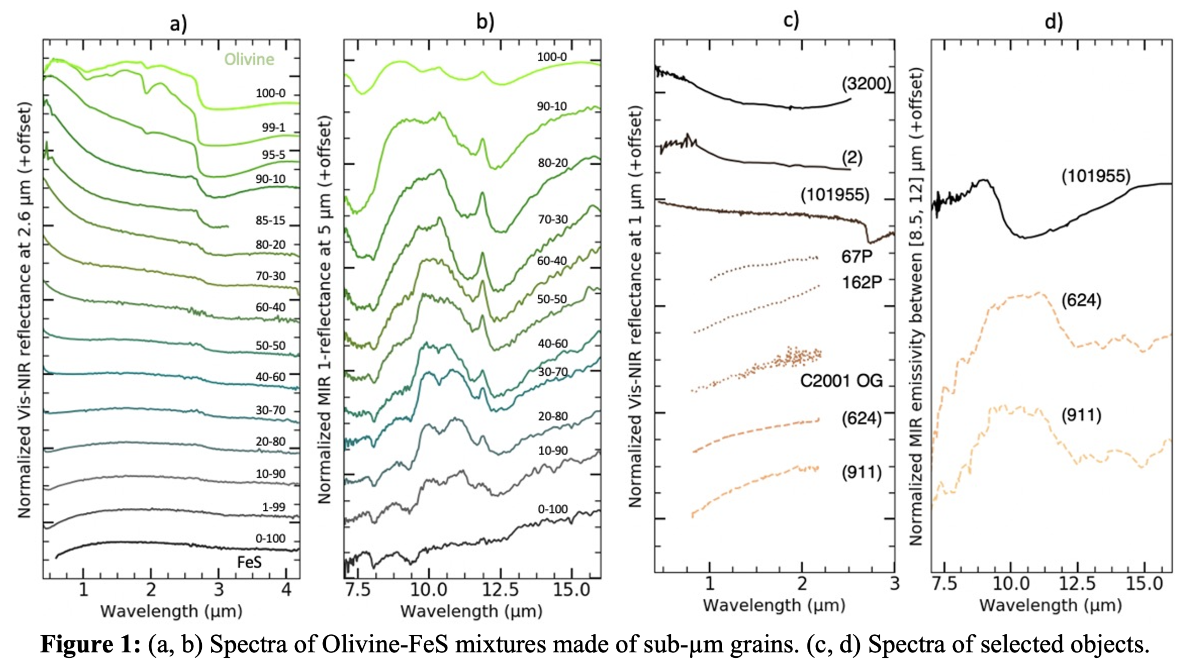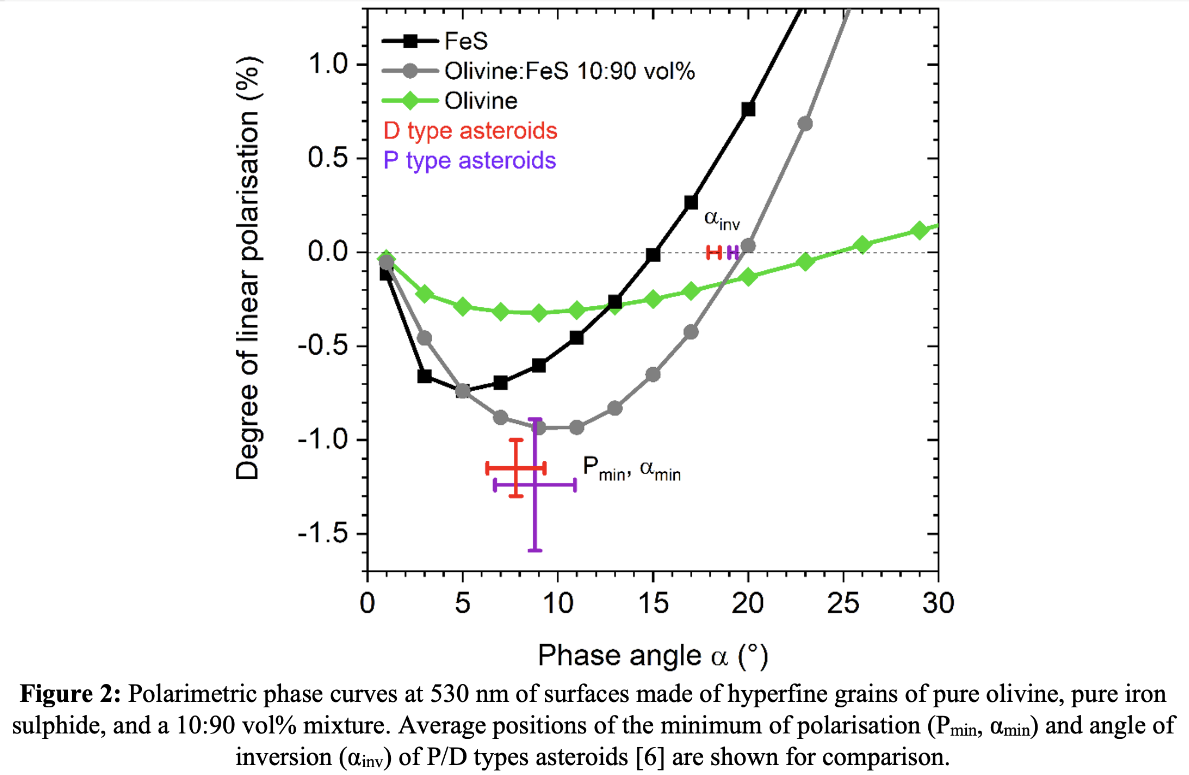Hyperfine grains can explain altogether the Vis-NIR spectral slope, MIR emissivity, and V-band polarimetric phase curves of primitive small bodies
- 1Univ. Grenoble Alpes, CNRS, IPAG, 38000 Grenoble, France (olivier.poch@univ-grenoble-alpes.fr)
- 2NCCR PlanetS and Physikalisches Institut, University of Bern, Switzerland
- 3now at LATMOS, 11 Boulevard d'Alembert 78280 Guyancourt, France
Introduction
Solar System small bodies are presumed relics from the eve of the Solar System, as they were the first objects to accrete inside the protoplanetary disk. The P-/D-type asteroids are particularly interesting because of the similarity of their spectra, in the visible (Vis) and near infrared (NIR) wavelengths, with cometary nuclei, suggesting that they are the most primitive types of small bodies [1-3]. In the mid-infrared (MIR), emission spectra of both P-/D-type asteroids surfaces and cometary comae display a signature around 10 µm due to the fundamental mode of vibrations of Si-O in silicates [2, 4-5]. P-/D-type asteroids are among the low-albedo class, and are characterized by linear polarimetric phase curves in V-band with a minimum of polarization around 1.2 ± 0.4 % and an inversion angle around 8.5 ± 2.5° [6].
There are various indications that the surface of these primitive small bodies are covered by so-called “hyperfine” grains, with individual grain sizes smaller than the wavelength at which they are observed (< 1 µm) [7]. The spectral characteristics of these objects in the Vis-NIR and MIR have also been attributed to their peculiar micro-texture and grain size [4, 5]. Here, we investigate how the Vis-NIR spectra, MIR spectra and Vis polarimetric phase curves of surfaces made of hyperfine grains are influenced by the relative abundance of materials having strongly different optical indexes.
Methods
We used olivine and iron sulphide (a mixture of pyrrhotite and troilite; labelled as “FeS”) having contrasted optical indexes. Following a dedicated grinding protocol, we have produced grains of average diameter ranging from 0.3 to 0.6 µm, as imaged by electron microscopy [8]. Mixtures were produced by mixing the two powders in a mortar manually with the pestle for about 10 min. Reflectance spectra in the Vis-NIR range were obtained at IPAG with the SHADOWS instrument [9] (emergence e=30º, incidence i=0º). MIR reflectance spectra were obtained using a Brucker Vertex 70V FT-IR spectrometer equipped with a reflectance kit A513/QA. Because small bodies MIR observations are emissivity spectra, we show on Figure 1b the experimental spectra as “1 - reflectance” to approximate their emissivity spectra according to the Kirchhoff’s law. Polarimetric phase curves were measured at the University of Bern with the POLICES instrument at 530 nm [10].
Results
Figure 1a presents the evolution of normalized reflectance spectra of olivine-FeS mixtures with decreasing volume concentration of olivine. We observe a general decrease of reflectance, associated to a modification of the spectral slope, as the concentration of FeS (opaque in the Vis) increases, with a blueing followed by a reddening of the spectra (Fig. 1a). The measurements reveal that mixtures of hyperfine grains made of two components with contrasted optical indexes have spectral and polarimetric properties which varies in strongly nonlinear way in the Vis-NIR (Fig. 1a,b, Fig. 2). In the MIR, while the spectra of the endmembers are relatively flat, the spectra of mixtures containing high concentrations of FeS exhibit the absorption bands of Si-O in the olivine around 10 µm.
Discussion
Spectra of mixtures of olivine and iron sulphide (or anthracite, not shown here) exhibit an emissivity feature in the MIR and various degree of bluing or reddening in the Vis-NIR, as observed on several small bodies (Fig. 1). Moreover, the same mixtures exhibiting the 10-µm feature also have a polarimetric phase curve similar to P-/D-type asteroids (Fig. 2).
Spectra of pure olivine, or mixtures with high concentration of olivine exhibit spectral features mainly due to reflectivity effects. As the concentration of FeS grains increases, these features are progressively replaced by the absorption bands of olivine material, maximum around 10 to 11 µm. In these cases, the olivine grains are well dispersed in a matrix of FeS grains which diffuse the light and enable photons to escape the sample after some absorption by olivine grains. A similar mechanism was pointed out with mixtures in KBr [5], but while mixtures with KBr are very reflective, mixtures with FeS have a much lower reflectance, compatible with the low reflectance and high emissivity values observed on small bodies.
The resemblance between mid-IR spectra of our hyperfine mixtures and P-/D-type asteroids emission feature (Fig. 1d) implies that elevated porosity is not a requirement for the presence of a silicate signatures at 10 µm. We show here that a relatively compact surface (porosity of the order of 50 %) exhibits similar mid-IR feature as cometary dust tails. An interpretation that can be proposed is that in both cases an optical separation of olivine grains occurred, whether by vacuum in the case of comae, or by optically featureless grains in the case of P-/D-type asteroids.
Finally, we note that some mixtures of hyperfine grains (such as olivine-FeS 10:90 vol%) exhibit altogether a red spectral slope in the Vis-NIR, a 10-µm feature in the MIR, and a V-band polarimetric phase curve similar to P-/D-type asteroids, reinforcing the hypothesize that these bodies are made of powdery mixtures of hyperfine grains.
Acknowledgments: We acknowledge funding from the European Research Council (ERC) (SOLARYS ERC-CoG2017_771691)


References: [1] Capaccioni et al. (2015) Science 347, 6620. [2] Vernazza and Beck (2017) in Planetesimals, Cambridge Univ. Press. [3] Poch et al. (2020) Science 367, 6483. [4] Emery et al. (2006) Icarus 182, 496-512. [5] Vernazza et al. (2012) Icarus 221, 1162–1172. [6] Belskaya et al. (2017) Icarus 284, 30–42. [7] Levasseur-Regourd et al. (2018) Space Sci Rev 214. [8] Sultana et al. (2021) Icarus 35, 11412. [7] Mustard and Hays (1997) Icarus 125, 145-163. [9] Potin et al. (2018) App. Optics 57, 28. [10] Poch, (2018) JGR Planets, 123.
How to cite: Poch, O., Sultana, R., Beck, P., Spadaccia, S., Patty, L., Pommerol, A., Quirico, E., and Schmitt, B.: Hyperfine grains can explain altogether the Vis-NIR spectral slope, MIR emissivity, and V-band polarimetric phase curves of primitive small bodies, Europlanet Science Congress 2022, Granada, Spain, 18–23 Sep 2022, EPSC2022-821, https://doi.org/10.5194/epsc2022-821, 2022.

